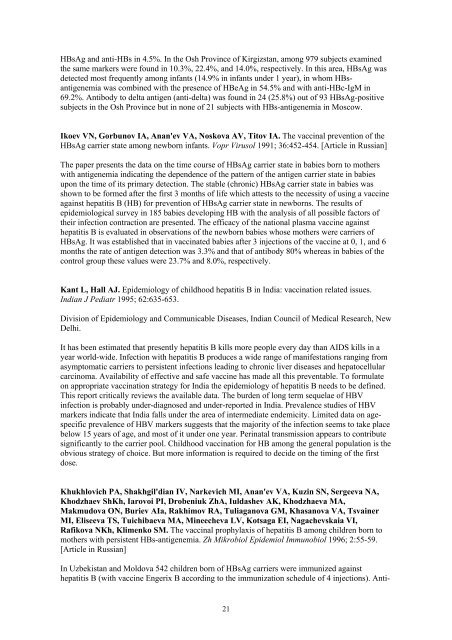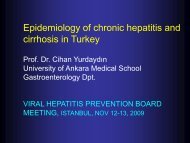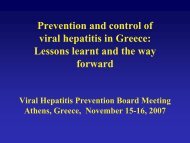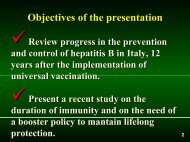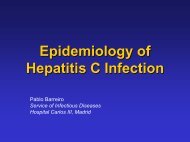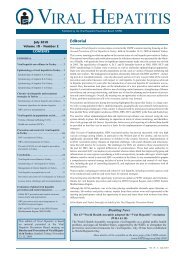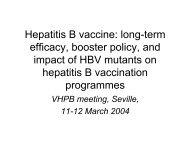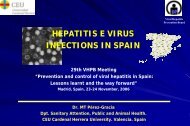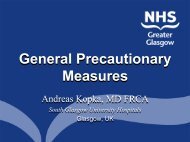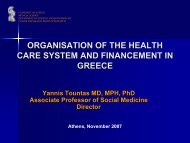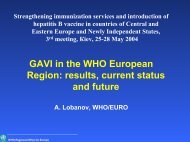Hipgrave DB, Tran TN, Huong VM, Dat DT, Nga NT, Long HT, VAN NT, Maynard JE,Biggs BA. Immunogenicity <strong>of</strong> a locally produced <strong>hepatitis</strong> B vacc<strong>in</strong>e with the birth dose storedoutside the cold cha<strong>in</strong> <strong>in</strong> rural Vietnam. Am J Trop Med Hyg 2006; 74:255-260.International Health Unit, Burnet Institute, Alfred Medical Research <strong>and</strong> Education Prec<strong>in</strong>ct,Prahran, Victoria, Australia; Department <strong>of</strong> Medic<strong>in</strong>e (Royal Melbourne Hospital/WesternHospital), University <strong>of</strong> Melbourne, Royal Melbourne Hospital, Parkville, Australia; Department<strong>of</strong> Medical Epidemiology <strong>and</strong> Biostatistics, Karol<strong>in</strong>ska Institute, Stockholm, Sweden; NationalInstitute <strong>of</strong> Hygiene <strong>and</strong> Epidemiology, Hanoi, Vietnam; Program for Appropriate Technology <strong>in</strong>Health, Hanoi, Vietnam.The heat stability <strong>of</strong> <strong>hepatitis</strong> B vacc<strong>in</strong>e (HepB vacc<strong>in</strong>e) should enable its storage outside the coldcha<strong>in</strong> (OCC), <strong>in</strong>creas<strong>in</strong>g access to the birth dose <strong>in</strong> areas lack<strong>in</strong>g refrigeration. We compared theimmunogenicity <strong>of</strong> a locally produced vacc<strong>in</strong>e among <strong>in</strong>fants who received three doses storedwith<strong>in</strong> the cold cha<strong>in</strong> (n = 358) or for whom the first dose was stored OCC for up to one month (n= 748). Serum was collected from these <strong>in</strong>fants at age 9-18 months. The vacc<strong>in</strong>e was protective <strong>in</strong>80.3% <strong>of</strong> all <strong>in</strong>fants. There were no differences <strong>in</strong> the prevalence <strong>of</strong> a protective level <strong>of</strong> antibodyor antibody titer among groups <strong>of</strong> <strong>in</strong>fants accord<strong>in</strong>g to storage strategy. Differences <strong>in</strong> antibodytiter between certa<strong>in</strong> groups <strong>of</strong> <strong>in</strong>fants could be expla<strong>in</strong>ed by different vacc<strong>in</strong>ation schedules.Where birth dose coverage will be improved, HepB vacc<strong>in</strong>e can be taken OCC for up to onemonth without affect<strong>in</strong>g its immunogenicity.Huang K, L<strong>in</strong> S. Nationwide vacc<strong>in</strong>ation: a success story <strong>in</strong> Taiwan. Vacc<strong>in</strong>e 2000 18; 18(Suppl1):S35-S38.Department <strong>of</strong> Microbiology, National Cheng Kung University Medical College, Ta<strong>in</strong>an, Taiwan.In the early 1980s, 15-20% <strong>of</strong> the population <strong>of</strong> Taiwan were estimated to be <strong>hepatitis</strong> B <strong>virus</strong>(HBV) carriers. A programme <strong>of</strong> mass vacc<strong>in</strong>ation aga<strong>in</strong>st <strong>hepatitis</strong> B was therefore launched <strong>in</strong>1984. In the first 2 years, newborns <strong>of</strong> all HBVsurface antigen (HBsAg)-positive mothers werevacc<strong>in</strong>ated. S<strong>in</strong>ce 1986, all newborns, <strong>and</strong> then year by year pre-school children, primary schoolchildren, adolescents, young adults <strong>and</strong> others have also been vacc<strong>in</strong>ated. Vacc<strong>in</strong>ation coverage isover 90% for newborns, with 79% <strong>of</strong> pregnant women screened for HBsAg. The proportion <strong>of</strong>babies born to highly <strong>in</strong>fectious carrier mothers who also became carriers decreased from 86-96%to 12-14%; the decrease was from 10-12% to 3-4% for babies <strong>of</strong> less <strong>in</strong>fectious mothers. Between1989 <strong>and</strong> 1993, the prevalence <strong>of</strong> HBsAg <strong>in</strong> children aged 6 years also fell from 10.5 to 1.7%. Theaverage annual <strong>in</strong>cidence <strong>of</strong> hepatocellular carc<strong>in</strong>oma <strong>in</strong> children aged 6-14 years decreasedsignificantly from 0.7 per 100,000 <strong>in</strong> 1981-1986 to 0.36 per 100,000 <strong>in</strong> 1990-1994 (P < 0.01).Similarly, the annual <strong>in</strong>cidence <strong>of</strong> hepatocellular carc<strong>in</strong>oma <strong>in</strong> children aged 6-9 years decl<strong>in</strong>edfrom 0.52 per 100,000 for those born <strong>in</strong> 1974-1984 to 0.13 per 100,000 for those born <strong>in</strong> 1986-1988 (P < 0.001). The mass vacc<strong>in</strong>ation programme is highly effective <strong>in</strong> <strong>control</strong>l<strong>in</strong>g chronic HBV<strong>in</strong>fection <strong>and</strong> <strong>in</strong> prevent<strong>in</strong>g liver cancer <strong>in</strong> Taiwan. If a coverage rate <strong>of</strong> 90% <strong>of</strong> all newbornsvacc<strong>in</strong>ated aga<strong>in</strong>st <strong>hepatitis</strong> B can be ma<strong>in</strong>ta<strong>in</strong>ed, by the year 2010 the carrier rate <strong>in</strong> Taiwan isexpected to decl<strong>in</strong>e to < 0.1%.Iash<strong>in</strong>a TL, Favorov MO, Shakhgil'dian IV, Firsova SN, Eraliev AE, Zhukova LD,Reznichenko RG. The prevalence <strong>of</strong> the markers <strong>of</strong> viral <strong>hepatitis</strong> B <strong>and</strong> delta among thepopulation <strong>in</strong> regions differ<strong>in</strong>g <strong>in</strong> the level <strong>of</strong> morbidity. Vopr Virusol 1992; 37:194-196. [Article<strong>in</strong> Russian]From two regions differ<strong>in</strong>g by the levels <strong>of</strong> <strong>in</strong>cidence <strong>of</strong> <strong>hepatitis</strong> B, 2019 blood serum specimensfrom normal population were exam<strong>in</strong>ed for markers <strong>of</strong> HBV <strong>in</strong>fection. In Moscow, among 1040samples exam<strong>in</strong>ed HBsAg was found <strong>in</strong> 2.0%, anti-HBs <strong>in</strong> 10.0%, anti-HBc <strong>in</strong> the absence <strong>of</strong>20
HBsAg <strong>and</strong> anti-HBs <strong>in</strong> 4.5%. In the Osh Prov<strong>in</strong>ce <strong>of</strong> Kirgizstan, among 979 subjects exam<strong>in</strong>edthe same markers were found <strong>in</strong> 10.3%, 22.4%, <strong>and</strong> 14.0%, respectively. In this area, HBsAg wasdetected most frequently among <strong>in</strong>fants (14.9% <strong>in</strong> <strong>in</strong>fants under 1 year), <strong>in</strong> whom HBsantigenemiawas comb<strong>in</strong>ed with the presence <strong>of</strong> HBeAg <strong>in</strong> 54.5% <strong>and</strong> with anti-HBc-IgM <strong>in</strong>69.2%. Antibody to delta antigen (anti-delta) was found <strong>in</strong> 24 (25.8%) out <strong>of</strong> 93 HBsAg-positivesubjects <strong>in</strong> the Osh Prov<strong>in</strong>ce but <strong>in</strong> none <strong>of</strong> 21 subjects with HBs-antigenemia <strong>in</strong> Moscow.Ikoev VN, Gorbunov IA, Anan'ev VA, Noskova AV, Titov IA. The vacc<strong>in</strong>al prevention <strong>of</strong> theHBsAg carrier state among newborn <strong>in</strong>fants. Vopr Virusol 1991; 36:452-454. [Article <strong>in</strong> Russian]The paper presents the data on the time course <strong>of</strong> HBsAg carrier state <strong>in</strong> babies born to motherswith antigenemia <strong>in</strong>dicat<strong>in</strong>g the dependence <strong>of</strong> the pattern <strong>of</strong> the antigen carrier state <strong>in</strong> babiesupon the time <strong>of</strong> its primary detection. The stable (chronic) HBsAg carrier state <strong>in</strong> babies wasshown to be formed after the first 3 months <strong>of</strong> life which attests to the necessity <strong>of</strong> us<strong>in</strong>g a vacc<strong>in</strong>eaga<strong>in</strong>st <strong>hepatitis</strong> B (HB) for prevention <strong>of</strong> HBsAg carrier state <strong>in</strong> newborns. The results <strong>of</strong>epidemiological survey <strong>in</strong> 185 babies develop<strong>in</strong>g HB with the analysis <strong>of</strong> all possible factors <strong>of</strong>their <strong>in</strong>fection contraction are presented. The efficacy <strong>of</strong> the national plasma vacc<strong>in</strong>e aga<strong>in</strong>st<strong>hepatitis</strong> B is evaluated <strong>in</strong> observations <strong>of</strong> the newborn babies whose mothers were carriers <strong>of</strong>HBsAg. It was established that <strong>in</strong> vacc<strong>in</strong>ated babies after 3 <strong>in</strong>jections <strong>of</strong> the vacc<strong>in</strong>e at 0, 1, <strong>and</strong> 6months the rate <strong>of</strong> antigen detection was 3.3% <strong>and</strong> that <strong>of</strong> antibody 80% whereas <strong>in</strong> babies <strong>of</strong> the<strong>control</strong> group these values were 23.7% <strong>and</strong> 8.0%, respectively.Kant L, Hall AJ. Epidemiology <strong>of</strong> childhood <strong>hepatitis</strong> B <strong>in</strong> India: vacc<strong>in</strong>ation related issues.Indian J Pediatr 1995; 62:635-653.Division <strong>of</strong> Epidemiology <strong>and</strong> Communicable Diseases, Indian Council <strong>of</strong> Medical Research, NewDelhi.It has been estimated that presently <strong>hepatitis</strong> B kills more people every day than AIDS kills <strong>in</strong> ayear world-wide. Infection with <strong>hepatitis</strong> B produces a wide range <strong>of</strong> manifestations rang<strong>in</strong>g fromasymptomatic carriers to persistent <strong>in</strong>fections lead<strong>in</strong>g to chronic liver diseases <strong>and</strong> hepatocellularcarc<strong>in</strong>oma. Availability <strong>of</strong> effective <strong>and</strong> safe vacc<strong>in</strong>e has made all this preventable. To formulateon appropriate vacc<strong>in</strong>ation strategy for India the epidemiology <strong>of</strong> <strong>hepatitis</strong> B needs to be def<strong>in</strong>ed.This report critically reviews the available data. The burden <strong>of</strong> long term sequelae <strong>of</strong> HBV<strong>in</strong>fection is probably under-diagnosed <strong>and</strong> under-reported <strong>in</strong> India. Prevalence studies <strong>of</strong> HBVmarkers <strong>in</strong>dicate that India falls under the area <strong>of</strong> <strong>in</strong>termediate endemicity. Limited data on agespecificprevalence <strong>of</strong> HBV markers suggests that the majority <strong>of</strong> the <strong>in</strong>fection seems to take placebelow 15 years <strong>of</strong> age, <strong>and</strong> most <strong>of</strong> it under one year. Per<strong>in</strong>atal <strong>transmission</strong> appears to contributesignificantly to the carrier pool. Childhood vacc<strong>in</strong>ation for HB among the general population is theobvious strategy <strong>of</strong> choice. But more <strong>in</strong>formation is required to decide on the tim<strong>in</strong>g <strong>of</strong> the firstdose.Khukhlovich PA, Shakhgil'dian IV, Narkevich MI, Anan'ev VA, Kuz<strong>in</strong> SN, Sergeeva NA,Khodzhaev ShKh, Iarovoi PI, Drobeniuk ZhA, Iuldashev AK, Khodzhaeva MA,Makmudova ON, Buriev AIa, Rakhimov RA, Tuliaganova GM, Khasanova VA, Tsva<strong>in</strong>erMI, Eliseeva TS, Tuichibaeva MA, M<strong>in</strong>eecheva LV, Kotsaga EI, Nagachevskaia VI,Rafikova NKh, Klimenko SM. The vacc<strong>in</strong>al prophylaxis <strong>of</strong> <strong>hepatitis</strong> B among children born tomothers with persistent HBs-antigenemia. Zh Mikrobiol Epidemiol Immunobiol 1996; 2:55-59.[Article <strong>in</strong> Russian]In Uzbekistan <strong>and</strong> Moldova 542 children born <strong>of</strong> HBsAg carriers were immunized aga<strong>in</strong>st<strong>hepatitis</strong> B (with vacc<strong>in</strong>e Engerix B accord<strong>in</strong>g to the immunization schedule <strong>of</strong> 4 <strong>in</strong>jections). Anti-21
- Page 1 and 2: Pre-meeting documentPrevention and
- Page 3 and 4: Part I Prevention and control of pe
- Page 5 and 6: prevalence was significantly higher
- Page 7 and 8: clusters (obstetrics wards/hospital
- Page 9 and 10: Boxall E. Screening of pregnant wom
- Page 11 and 12: Chang MH, Hsu HY, Huang LM, Lee PI,
- Page 13 and 14: of infection in infants and childre
- Page 15 and 16: Eriksen EM, Perlman JA, Miller A, M
- Page 17 and 18: liver enzyme abnormalities than wer
- Page 19: health care, is feasible and achiev
- Page 23 and 24: immunoprophylaxis. Reflecting effec
- Page 25 and 26: Levin CE, Nelson CM, Widjaya A, Mon
- Page 27 and 28: Delaying vaccination of premature i
- Page 29 and 30: diagnosis. In the past, the inciden
- Page 31 and 32: shows that the prevalence of HBV in
- Page 33 and 34: Niu MT, Targonski PV, Stoll BJ, Alb
- Page 35 and 36: Ranger-Rogez S, Alain S, Denis F. H
- Page 37 and 38: vaccinees) and low reactogenicity o
- Page 39 and 40: single ELISA test is about Rs40. At
- Page 41 and 42: newborns with surface antigenemia,
- Page 43 and 44: Wang Z, Zhang J, Yang H, Li X, Wen
- Page 45 and 46: of hepatitis B vaccine. This study
- Page 47 and 48: transmission has been estimated at
- Page 49 and 50: at birth and 2 weeks after birth, f
- Page 51 and 52: Chubinishvili OV, Mikhailov MI, Sak
- Page 53 and 54: Jensen L, Heilmann C, Smith E, Want
- Page 55 and 56: Onishchenko GG. Incidence of infect
- Page 57: Zanetti A, Tanzi E, Semprini AE. He


